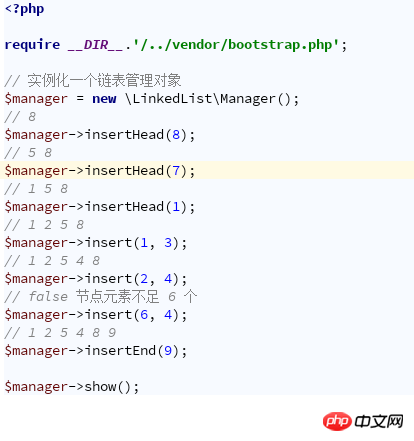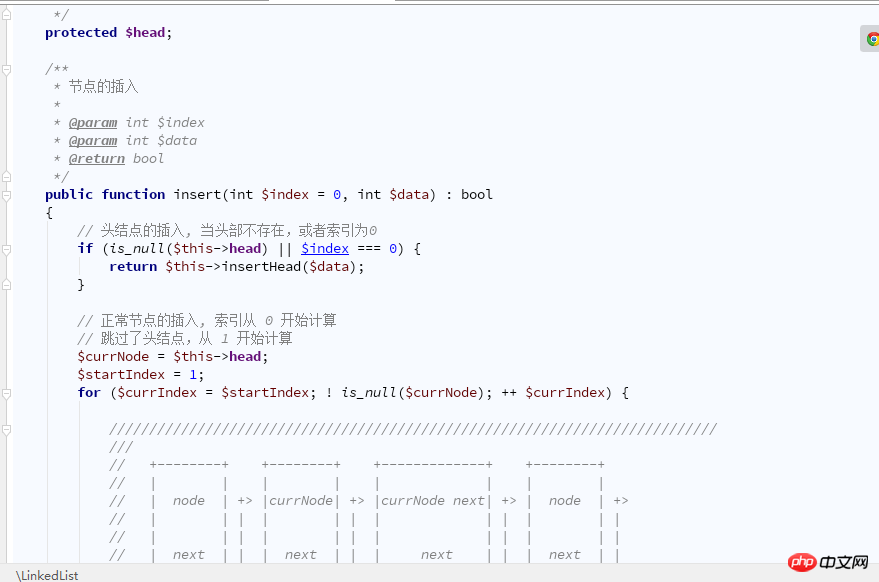鍊錶在PHP中的實現
這篇文章介紹的內容是關於鍊錶在PHP中的實現,有著一定的參考價值,現在分享給大家,有需要的朋友可以參考一下
開始對資料結構的學習
今天寫程式碼換了一個字體,以前一直用console很好看,今天發現一個更喜歡的風格Source Code Pro
上兩張圖,還挺好看的! ! ! 

已步入正題,講講鍊錶的運算
節點
#首先得有一個節點類,用於儲存資料
<?phpnamespace LinkedList;class Node{
/**
* @var $data integer
*/
public $data; /**
* 节点指向的下一个元素
*
* @var $next Node
*/
public $next; public function __construct(int $data = -1)
{
public function __construct(int $data = null)
{
// 初始化赋值 data,也可通过 $node->data = X; 赋值
$this->data = $data;
}
}鍊錶管理類別(用於操作節點資料)
操作類別的程式碼由於太長,我們分部分解析
頭插入(因為比較簡單,所以先講這個)
聽名字,就知道是從頭部插入一個節點
當鍊錶為空,則初始化目前節點
當鍊錶不為空,把新節點當作頭結點
public function insertHead(int $data) : bool{
///////////////////////////////////////////////////////////////////////////
// +-----------+ +--------+ +--------+
// | | | | | |
// | head node | +> | node | +> | node | +>
// | | | | | | | | |
// | | | | | | | | |
// | next | | | next | | | next | |
// +------+----+ | +----+---+ | +----+---+ |
// | | | | | |
// +------+ +-----+ +-----+
///////////////////////////////////////////////////////////////
// +-----------+ +--------+ +--------+
// | | | | | |
// +---> | head node | +> | node | +> | node | +>
// | | | | | | | | | |
// | | | | | | | | | |
// | | next | | | next | | | next | |
// | +------+----+ | +----+---+ | +----+---+ |
// | | | | | | |
// +--------+ | +------+ +-----+ +-----+
// | | |
// |new node| |
// | | |
// | | |
// | next | |
// +----+---+ |
// | |
// +-----+
//
// 1. 实例化一个数据节点
// 2. 使当前节点的下一个等于现在的头结点
// 即使当前头结点是 null,也可成立
// 3. 使当前节点成为头结点
// 即可完成头结点的插入
$newNode = new Node($data); $newNode->next = $this->head; $this->head = $newNode; return true;
}插入節點(index=0 是頭結點,依序下去,超出位置回傳false)
public function insert(int $index = 0, int $data) : bool{
// 头结点的插入, 当头部不存在,或者索引为0
if (is_null($this->head) || $index === 0) { return $this->insertHead($data);
} // 正常节点的插入, 索引从 0 开始计算
// 跳过了头结点,从 1 开始计算
$currNode = $this->head; $startIndex = 1; // 遍历整个链表,如果当前节点是 null,则代表到了尾部的下一个,退出循环
for ($currIndex = $startIndex; ! is_null($currNode); ++ $currIndex) { ////////////////////////////////////////////////////////////////////////////
///
// +--------+ +--------+ +-------------+ +--------+
// | | | | | | | |
// | node | +> |currNode| +> |currNode next| +> | node | +>
// | | | | | | | | | | | |
// | | | | | | | | | | | |
// | next | | | next | | | next | | | next | |
// +----+---+ | +----+---+ | +------+------+ | +----+---+ |
// | | | | | | | |
// +-----+ +-----+ +--------+ +-----+
////////////////////////////////////////////////////////////////////////////
// +--------+ +--------+ +-------------+ +--------+
// | | | | | | | |
// | node | +> |currNode| +> |currNode next| +> | node | +>
// | | | | | | | | | | | |
// | | | | | | | | | | | |
// | next | | | next | | | next | | | next | |
// +----+---+ | +--------+ | +------+------+ | +----+---+ |
// | | +--------+ | | | | |
// +-----+ | | | +--------+ +-----+
// |new node| |
// | | |
// | | |
// | next | |
// +----+---+ |
// | |
// +-----+
////////////////////////////////////////////////////////////////////////////
//
// +--------+ +--------+ +-------------+ +--------+
// | | | | | | | |
// | node | +> |currNode| +> |currNode next| +> | node | +>
// | | | | | | | | | | | |
// | | | | | | | | | | | |
// | next | | | next | | | next | | | next | |
// +----+---+ | +----+---+ | +------+------+ | +----+---+ |
// | | | +--------+ | | | | |
// +-----+ | | | | +--------+ +-----+
// +----> |new node| |
// | | |
// | | |
// | next | |
// +----+---+ |
// | |
// +-----+
//
// 1. 当前索引等于传入参数的索引
// 2. 实例化新数据节点
// 3. 新节点的下一个指向当前节点的下一个节点
// 4. 当前节点的下一个节点指向新节点
if ($currIndex === $index) { $newNode = new Node($data); $newNode->next = $currNode->next; $currNode->next = $newNode; return true;
} // 移动到下一个节点
$currNode = $currNode->next;
} return false;
}以上兩個這是插入的基本操作。看一下實例的程式碼。
<?php // 自动加载的代码就不贴了,直接在 githubrequire __DIR__.'/../vendor/bootstrap.php'; // 实例化一个链表管理对象$manager = new \LinkedList\Manager(); // 8$manager->insertHead(8); // 5 8$manager->insertHead(5); // 1 5 8$manager->insertHead(1); // 1 2 5 8$manager->insert(1, 2); // false 节点元素不足 6 个$manager->insert(5, 4); // 1 2 5 8 9$manager->insertEnd(9); // 3$manager->find(8); // 1 2 8 9$manager->delete(2);
找出
尋找鍊錶的值也是很簡單的,只要遍歷即可
/**
* 查找链表的值中的索引
* 成功返回索引值,找不到返回 -1
*
* @param int $data
* @return int
*/public function find(int $data) : int{
$currNode = $this->head; // 查找还是很简单的,只要遍历一次链表,然后再判断值是否相等就可以了
for ($i = 0; ! is_null($currNode); ++ $i) { if ($currNode->data === $data) { return $i;
} $currNode = $currNode->next;
} return -1;
}只需要遍歷一次鍊錶,找到相等的值,找到返回索引值,找不到返回-1
#刪除
/**
* 删除链表的节点
*
* @param int $index
* @return bool
*/public function delete(int $index) : bool{
// 没有任何节点,直接跳过
if (is_null($this->head)) { return false;
} elseif ($index === 0) { // 头结点的删除
$this->head = $this->head->next;
} // 这里的开始的索引是 1
// 但当前节点指向的确实 头结点
// 因为删除的时候必须标记删除的前一个节点
// for 的判断是判断下一个节点是否为 null
// $currNode 是操作的节点
// $currNode->next 是要删除的节点
$startIndex = 1; $currNode = $this->head; for ($i = $startIndex; ! is_null($currNode->next); ++ $i) { if ($index === $i) { // 使当前节点等于要删除节点的下一个
// 即可完成删除
$currNode->next = $currNode->next->next; break;
} $currNode = $currNode->next;
} return true;
}End
程式碼已託管在github
後續有時間繼續學習資料結構,雙鍊錶,樹之類的! ! !
相關推薦:
#以上是鍊錶在PHP中的實現的詳細內容。更多資訊請關注PHP中文網其他相關文章!

熱AI工具

Undresser.AI Undress
人工智慧驅動的應用程序,用於創建逼真的裸體照片

AI Clothes Remover
用於從照片中去除衣服的線上人工智慧工具。

Undress AI Tool
免費脫衣圖片

Clothoff.io
AI脫衣器

Video Face Swap
使用我們完全免費的人工智慧換臉工具,輕鬆在任何影片中換臉!

熱門文章

熱工具

記事本++7.3.1
好用且免費的程式碼編輯器

SublimeText3漢化版
中文版,非常好用

禪工作室 13.0.1
強大的PHP整合開發環境

Dreamweaver CS6
視覺化網頁開發工具

SublimeText3 Mac版
神級程式碼編輯軟體(SublimeText3)
 適用於 Ubuntu 和 Debian 的 PHP 8.4 安裝和升級指南
Dec 24, 2024 pm 04:42 PM
適用於 Ubuntu 和 Debian 的 PHP 8.4 安裝和升級指南
Dec 24, 2024 pm 04:42 PM
PHP 8.4 帶來了多項新功能、安全性改進和效能改進,同時棄用和刪除了大量功能。 本指南介紹如何在 Ubuntu、Debian 或其衍生版本上安裝 PHP 8.4 或升級到 PHP 8.4
 如何設定 Visual Studio Code (VS Code) 進行 PHP 開發
Dec 20, 2024 am 11:31 AM
如何設定 Visual Studio Code (VS Code) 進行 PHP 開發
Dec 20, 2024 am 11:31 AM
Visual Studio Code,也稱為 VS Code,是一個免費的原始碼編輯器 - 或整合開發環境 (IDE) - 可用於所有主要作業系統。 VS Code 擁有大量針對多種程式語言的擴展,可以輕鬆編寫
 在PHP API中說明JSON Web令牌(JWT)及其用例。
Apr 05, 2025 am 12:04 AM
在PHP API中說明JSON Web令牌(JWT)及其用例。
Apr 05, 2025 am 12:04 AM
JWT是一種基於JSON的開放標準,用於在各方之間安全地傳輸信息,主要用於身份驗證和信息交換。 1.JWT由Header、Payload和Signature三部分組成。 2.JWT的工作原理包括生成JWT、驗證JWT和解析Payload三個步驟。 3.在PHP中使用JWT進行身份驗證時,可以生成和驗證JWT,並在高級用法中包含用戶角色和權限信息。 4.常見錯誤包括簽名驗證失敗、令牌過期和Payload過大,調試技巧包括使用調試工具和日誌記錄。 5.性能優化和最佳實踐包括使用合適的簽名算法、合理設置有效期、
 php程序在字符串中計數元音
Feb 07, 2025 pm 12:12 PM
php程序在字符串中計數元音
Feb 07, 2025 pm 12:12 PM
字符串是由字符組成的序列,包括字母、數字和符號。本教程將學習如何使用不同的方法在PHP中計算給定字符串中元音的數量。英語中的元音是a、e、i、o、u,它們可以是大寫或小寫。 什麼是元音? 元音是代表特定語音的字母字符。英語中共有五個元音,包括大寫和小寫: a, e, i, o, u 示例 1 輸入:字符串 = "Tutorialspoint" 輸出:6 解釋 字符串 "Tutorialspoint" 中的元音是 u、o、i、a、o、i。總共有 6 個元
 您如何在PHP中解析和處理HTML/XML?
Feb 07, 2025 am 11:57 AM
您如何在PHP中解析和處理HTML/XML?
Feb 07, 2025 am 11:57 AM
本教程演示瞭如何使用PHP有效地處理XML文檔。 XML(可擴展的標記語言)是一種用於人類可讀性和機器解析的多功能文本標記語言。它通常用於數據存儲
 解釋PHP中的晚期靜態綁定(靜態::)。
Apr 03, 2025 am 12:04 AM
解釋PHP中的晚期靜態綁定(靜態::)。
Apr 03, 2025 am 12:04 AM
靜態綁定(static::)在PHP中實現晚期靜態綁定(LSB),允許在靜態上下文中引用調用類而非定義類。 1)解析過程在運行時進行,2)在繼承關係中向上查找調用類,3)可能帶來性能開銷。
 什麼是PHP魔術方法(__ -construct,__destruct,__call,__get,__ set等)並提供用例?
Apr 03, 2025 am 12:03 AM
什麼是PHP魔術方法(__ -construct,__destruct,__call,__get,__ set等)並提供用例?
Apr 03, 2025 am 12:03 AM
PHP的魔法方法有哪些? PHP的魔法方法包括:1.\_\_construct,用於初始化對象;2.\_\_destruct,用於清理資源;3.\_\_call,處理不存在的方法調用;4.\_\_get,實現動態屬性訪問;5.\_\_set,實現動態屬性設置。這些方法在特定情況下自動調用,提升代碼的靈活性和效率。







